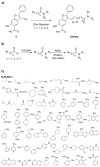Bicyclic benzofuran and indole-based salicylic acids as protein tyrosine phosphatase inhibitors
- PMID: 22133902
- PMCID: PMC3297712
- DOI: 10.1016/j.bmc.2011.11.004
Bicyclic benzofuran and indole-based salicylic acids as protein tyrosine phosphatase inhibitors
Abstract
Protein tyrosine phosphatases (PTPs) constitute a large and structurally diverse family of signaling enzymes that control the cellular levels of protein tyrosine phosphorylation. Malfunction of PTP activity has significant implications in many human diseases, and the PTP protein family provides an exciting array of validated diabetes/obesity (PTP1B), oncology (SHP2), autoimmunity (Lyp), and infectious disease (mPTPB) targets. However, despite the fact that PTPs have been garnering attention as novel therapeutic targets, they remain largely an untapped resource. The main challenges facing drug developers by the PTPs are inhibitor specificity and bioavailability. Work over the last ten years has demonstrated that it is feasible to develop potent and selective inhibitors for individual members of the PTP family by tethering together small ligands that can simultaneously occupy both the active site and unique nearby peripheral binding sites. Recent results with the bicyclic salicylic acid pharmacophores indicate that the new chemistry platform may provide a potential solution to overcome the bioavailability issue that has plagued the PTP drug discovery field for many years. Structural analysis of PTP-inhibitor complexes reveals molecular determinants important for the development of more potent and selective PTP inhibitors, thus offering hope in the medicinal chemistry of a largely unexploited protein class with a wealth of attractive drug targets.
Copyright © 2011 Elsevier Ltd. All rights reserved.
Figures





Similar articles
-
Protein tyrosine phosphatases as potential therapeutic targets.Acta Pharmacol Sin. 2014 Oct;35(10):1227-46. doi: 10.1038/aps.2014.80. Epub 2014 Sep 15. Acta Pharmacol Sin. 2014. PMID: 25220640 Free PMC article. Review.
-
Drugging the Undruggable: Therapeutic Potential of Targeting Protein Tyrosine Phosphatases.Acc Chem Res. 2017 Jan 17;50(1):122-129. doi: 10.1021/acs.accounts.6b00537. Epub 2016 Dec 15. Acc Chem Res. 2017. PMID: 27977138 Free PMC article.
-
Discovery and evaluation of novel inhibitors of mycobacterium protein tyrosine phosphatase B from the 6-Hydroxy-benzofuran-5-carboxylic acid scaffold.J Med Chem. 2013 Feb 14;56(3):832-42. doi: 10.1021/jm301781p. Epub 2013 Jan 25. J Med Chem. 2013. PMID: 23305444 Free PMC article.
-
Probing the molecular basis for potent and selective protein-tyrosine phosphatase 1B inhibition.J Biol Chem. 2002 Oct 25;277(43):41014-22. doi: 10.1074/jbc.M207347200. Epub 2002 Aug 21. J Biol Chem. 2002. PMID: 12193602
-
Protein tyrosine phosphatases: structure and function, substrate specificity, and inhibitor development.Annu Rev Pharmacol Toxicol. 2002;42:209-34. doi: 10.1146/annurev.pharmtox.42.083001.144616. Annu Rev Pharmacol Toxicol. 2002. PMID: 11807171 Review.
Cited by
-
Novel Agents and Emerging Strategies for Targeting the B-Cell Receptor Pathway in CLL.Mediterr J Hematol Infect Dis. 2012;4(1):e2012067. doi: 10.4084/MJHID.2012.067. Epub 2012 Oct 9. Mediterr J Hematol Infect Dis. 2012. PMID: 23170196 Free PMC article.
-
Efficient Syntheses of 1,2,3-Triazoloamide Derivatives Using Solid- and Solution-Phase Synthetic Approaches.Molecules. 2015 Nov 5;20(11):19984-20013. doi: 10.3390/molecules201119673. Molecules. 2015. PMID: 26556332 Free PMC article.
-
Protein tyrosine phosphatases as potential therapeutic targets.Acta Pharmacol Sin. 2014 Oct;35(10):1227-46. doi: 10.1038/aps.2014.80. Epub 2014 Sep 15. Acta Pharmacol Sin. 2014. PMID: 25220640 Free PMC article. Review.
-
Diversity-Oriented Synthesis for Novel, Selective and Drug-like Inhibitors for a Phosphatase from Mycobacterium Tuberculosis.Medchemcomm. 2014 Oct;5(10):1496-1499. doi: 10.1039/C4MD00099D. Medchemcomm. 2014. PMID: 25505942 Free PMC article.
-
Organocatalytic multicomponent reaction for the acquisition of a selective inhibitor of mPTPB, a virulence factor of tuberculosis.Chem Commun (Camb). 2013 Mar 11;49(20):2064-6. doi: 10.1039/c3cc38961h. Chem Commun (Camb). 2013. PMID: 23380872 Free PMC article.
References
Publication types
MeSH terms
Substances
Grants and funding
LinkOut - more resources
Full Text Sources
Chemical Information
Miscellaneous

